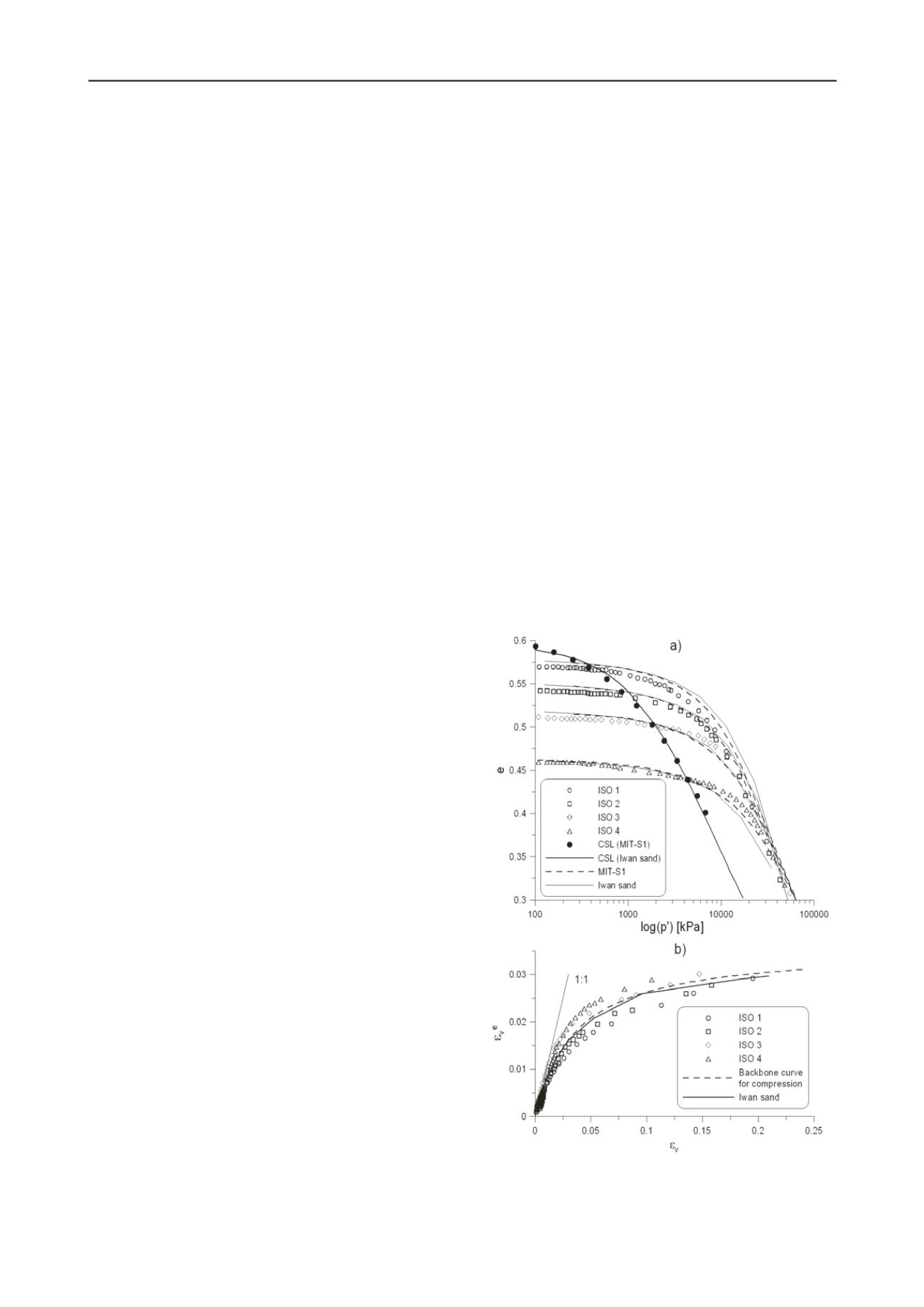
810
Proceedings of the 18
th
International Conference on Soil Mechanics and Geotechnical Engineering, Paris 2013
The unique shape of backbone curve is used for isotropic
compression, while the shape of the shearing backbone curve
depends on the
‘state of sand’.
The third unit of the model is the set of input parameters that
consists of: material parameters (characteristic for each type of
sand), parameters of initial conditions (initial void ratio
e
0
, over
consolidation ratio
OCR
and
K
0
NC
coefficient for primary
consolidation) and parameters of Iwan system (set of limit
displacements for shearing and compression
u
i
y
).
Detailed description of the 1D Iwan system can be found in
Iwan (1976) and Segelmen and Star (2008), and description of
the generalized 3D Iwan sand model in Sokolić (2010). The
model is developed within the critical state concept (Muir
Wood, 1990). It accounts for following characteristics of real
sand behavior:
-
unique critical state line;
-
single Mohr-Coulomb (MC) strength parameter for
critical state (angle of internal friction for critical state);
-
increase of peak strength for dense sand at low stress level
-
MC failure criteria for general 3D stress space;
-
high stiffness at small strains;
-
stiffness reduction due to shearing;
-
stress dependent dilatancy accounting for phase
transformation line concept;
-
limit compression line concept for isotropic compression
-
development of hysteresis for unloading and reloading
according to Massing rule
3
SOIL PROPERIES AND MODEL PARAMETERS
The soil profile at the site is characteristic for the geology of the
central area of Berlin that consists of saturated deposits of
quaternary age, reflecting three different glacial periods.
Typical profile at the site includes 3-4 m of fill, overlaying three
primary sandy till units: (1) S0, upper Holocene sand,
approximately 6 m with lower 1-m-thick organic soil unit; (2)
S1 glacial sands from the late Pleistocene period that are
typically 10 m thick; and (3) S2 glacial sand from the early
Pleistocene that are encountered approximately 22 m below the
ground surface. The local groundwater table is located 2 m
below the ground surface.
Berlin sand is poorly graded, fine-medium sand with rounded
particles, which are associated with fluvio-glacial deposition.
Mineral composition is mainly Quartz and Feldspar. The basic
physical properties of Berlin sand are:
e
min
= 0.39,
e
max
= 0.59,
G
s
= 2.65,
d
50
= 0.38,
C
u
= 3.0;
C
z
= 1.2. When compared with
other natural sands of similar particle size, shape and grading, it
is apparent that Berlin sand exhibits very low formations void
ratios and has a small range of formation conditions.
Mechanical properties of Berlin sand were tested with detailed
laboratory test program including a series of one-dimensional
consolidation tests up to high confining stresses, and including
drained and undrained triaxial tests for wide range of initial void
ration (
e
0
= 0.43 – 0.60) and consolidation pressure (
p
’ = 100,
500 and 800 kPa). The in-situ properties of sand units were
tested by heavy dynamic probing test (DPH) and cross-hole
measurements of shear velocity propagation. In this study only a
data available from published test results were used
(Nikolinakou, 2011).
3.1
Input parameters for Iwan sand model
The priority in defining the input parameters for the Iwan sand
model was the following:
a)
To take
material parameters directly from available
published results of laboratory test or
to accept
the values
adopted for MIT-S1 soil model, based on interpretation of
soil investigations (Nikolinakou, 2011)
b)
To derive
the parameters to best fit the material functions
used in MIT-S1 soil model (important for comparison of
the numerical simulation results performed by MIT-S1
and IWAN sand model)
c)
To calibrate
the material parameters by performing the
triaxial test simulations and compering the results to the
available published test results
d)
To adopt
material parameters from Iwan sand model
calibration performed on different types of sand (Sokolić,
2010)
Material parameters are defined for the set of material functions
describing the behavior of real sand observed in triaxial tests
(drained or undrained shearing and isotropic compression). All
material functions are related to the
‘state of sand’
which is
defined by current void ratio
e
, current isotropic pressure
p
’,
current critical void ratio
e
cv
(p’) and state index
I
s
, defined
similarly to the standard density index:
)
/
min
0
e ee e I
cv
cv
s
(1)
Minimum void ratio parameter is taken directly from laboratory
test (
e
min
= 0.39) while the in-situ profile of initial void ratio is
accepted from MIT-S1 numerical model (
e
0
S0
= 0.6,
e
0
S1
= 0.53,
e
0
S2
= 0.4). The initial soil density is interpreted according to the
DPH in situ measurements by using empirical correlations.
The initial
K
0
values were not directly measured. In the MIT-S1
numerical analysis the values are interpreted according to DPH
soil profile and taking in to account the geological deposition of
sand layers. The following values are accepted: (
K
0
S0
= 0.5,
K
0
S1
= 1.0,
K
0
S2
= 1.0).
Figure 2. a) Critical state line (CSL) interpretation and comparison of
predicted and ‘measured’ isotropic compression of Berlin sand; b)
Backbone curve for isotropic compression of Berlin sand derived from
odometer tests


